Table of Contents
The average enterprise now manages 275 SaaS applications and spends $49M annually on software, according to Zylo’s 2025 SaaS Management Index. Yet despite the scale of these investments, many organizations lack the visibility needed to manage them effectively. Redundant tools, decentralized purchasing, and unmanaged spend remain common—and costly.
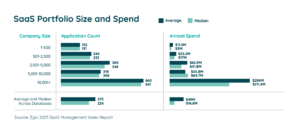
This is the consequence of SaaS sprawl. And it’s accelerating.
Organizations add an average of 7.6 new SaaS applications each month, totaling more than 91 annually. That contributes to a 33.2% year-over-year growth in portfolio size. At the same time, Gartner projects global SaaS spend will increase 19.2% in 2025, reaching $299B. As portfolios expand and pricing models evolve, complexity rises faster than most teams can manage.
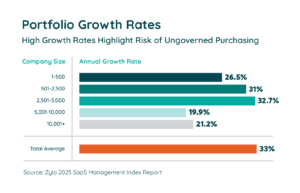
The result is a disconnect between software investment and software value. Without clear insights into usage, ownership, and contract terms, IT and Software Asset Management (SAM) leaders face mounting challenges around governance, cost control, and performance.
Tech stack consolidation offers a path forward.
By taking a structured, data-informed approach, organizations can reduce redundancies, reclaim underused licenses, and focus resources on tools that deliver measurable business impact. For example, consolidating three common high-sprawl categories—online training, project management, and team collaboration—can unlock between $477,000 and $2.8 million in potential cost savings.
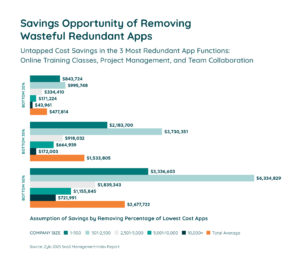
This guide outlines how to:
- Identify overlap and inefficiencies within your SaaS stack
- Realize cost savings and operational benefits through consolidation
- Avoid common mistakes that derail consolidation efforts
- Sustain results through ongoing SaaS Management
SaaS growth isn’t slowing down. Now’s the time to get proactive—and make consolidation part of your core IT strategy.
What Is Tech Stack Consolidation?
Tech stack consolidation is the practice of streamlining an organization’s software portfolio by removing redundant, underutilized, or unnecessary applications. It restores structure to fragmented SaaS environments—helping reduce waste, minimize risk, and improve usability.
As SaaS portfolios continue to grow (33% per year), so too does the need for consolidation. The challenge is that a majority of these applications are purchased outside of IT oversight—84% of applications on average. Often, this occurs without integration plans or governance. The result is a complex, uncoordinated stack that’s difficult to manage, secure, or optimize.

More Than Cost-Cutting
SaaS consolidation is about more than lowering software costs. While cost reduction is a measurable outcome, the broader value lies in eliminating waste, aligning software to business needs, and improving performance. It enables teams to use fewer tools more effectively.
A consolidated tech stack improves focus, simplifies support, and creates space for deeper adoption of high-value platforms. With better visibility, IT and SAM teams can make more informed decisions about where to invest and where to scale back.
Benefits Across the Business
Consolidation delivers impact across multiple roles and teams:
- IT and SaaS Managers gain visibility into usage, reduce sprawl, and streamline provisioning and offboarding.
- Software Asset Managers can automate license rightsizing, improve audit readiness, and enforce governance.
- Procurement teams strengthen vendor negotiations, manage renewals more strategically, and reduce duplicate spend.
- Finance leaders benefit from cleaner data for forecasting, allocation, and planning.
At Adobe, rationalizing a portfolio of more than 2,600 applications led to standardization across 400 tools. With Zylo, the company gained stronger control over its environment and positioned IT as a driver of operational efficiency.
Adobe Drives Innovation and Massive Savings with Zylo
In the past 4 years, Adobe has rapidly scaled from $9B to $18B. This growth has made an already complex environment even more complex. Learn how they leveraged Zylo to get complete visibility into their SaaS portfolio, unlock millions in cost savings and avoidance and improve the employee experience.
Signs It’s Time to Consolidate
A fragmented tech stack doesn’t self-correct. Common indicators that consolidation is overdue include:
- Overlapping applications across teams or functions
- Renewals for tools with little or no usage
- Multiple platforms offering the same functionality
- Gaps in visibility into usage, spend, or contract terms
When teams can’t confidently answer what applications they have—or how they’re being used—financial, operational, and security risks can quickly escalate.
Why Tech Stack Consolidation Matters Now
SaaS portfolios are expanding faster than most teams can manage. As decentralized purchasing increases and functional overlap becomes more common, organizations are spending more but realizing less value. Without a structured approach to consolidation, complexity grows—and so do financial, operational, and security risks.
Cost Efficiency and Reduced Spend
Redundancy across the stack directly affects the bottom line. Organizations can significantly reduce costs by targeting a few high-sprawl categories. For example, consolidating tools in online training, project management, and team collaboration alone can yield between $477,000 and $2.8 million in potential savings, based on Zylo data.
Through consolidation, organizations can:
- Eliminate shelfware and underused licenses
- Consolidate contracts to increase vendor leverage
- Reallocate spend to higher-value applications
These actions reduce waste and enable smarter investment across the portfolio.
Streamlined Management
Every new application introduces complexity: additional users to manage, more support tickets, and more systems to integrate. As the stack grows, so does the administrative burden on IT teams.
Consolidation simplifies operations by:
- Reducing the number of supported tools and vendors
- Centralizing user access and provisioning workflows
- Standardizing processes across departments
This helps IT teams shift from maintenance to strategy.
Productivity and Better Workflows
When teams toggle between multiple tools that serve similar functions, productivity suffers. Unclear guidance on which tool to use can lead to context switching, inconsistent adoption, and fragmented collaboration.
Consolidated stacks improve usability by:
- Focusing attention on high-value, widely adopted tools
- Delivering a consistent user experience across teams
- Enabling deeper engagement through simplification
With fewer systems in play, teams collaborate more effectively and stay aligned.
Security and Compliance
Redundant and unmanaged tools introduce risk. Zylo data shows that more than half of the average stack falls into the “Poor” or “Low” risk categories on Netskope’s Cloud Confidence Index, signaling potential gaps in compliance and data protection.
Reducing tool sprawl strengthens your security posture by:
- Limiting access points and entry vectors
- Increasing visibility into application usage
- Ensuring all tools meet internal and regulatory standards
With fewer applications, governance becomes more manageable.
Smarter Data Management
Siloed applications create fragmented data, conflicting reports, and inconsistent performance metrics. Without consolidation, teams often lack a single source of truth for usage, adoption, and value.
Consolidation improves data quality by:
- Centralizing metrics within unified dashboards
- Removing duplicate or conflicting reporting sources
- Enabling accurate analysis of usage and value
Reliable data supports better renewal planning, license optimization, and performance measurement.
How to Consolidate Your Tech Stack in 7 Steps
SaaS consolidation is a strategic, repeatable process—one that depends on visibility, cross-functional alignment, and operational execution. The seven steps below offer a structured approach to eliminate waste, reduce complexity, and embed governance across your portfolio.
1. Set Clear Goals
Begin with specific, measurable objectives. Clear goals not only guide the process but also help secure buy-in across stakeholders. Examples include:
- Reducing overall software spend by a set percentage
- Eliminating redundant applications within targeted categories
- Standardizing tools to improve employee experience and productivity
- Strengthening governance and compliance by closing oversight gaps
- Simplifying license workflows to reduce IT support burden
Each goal should tie directly to a business priority. This ensures consolidation efforts remain focused and can be tracked against meaningful outcomes.
2. Audit Your Existing Tech Stack
Start by building a complete, centralized inventory of your SaaS environment. This audit forms the foundation for every downstream decision and should account for tools acquired both through formal procurement and informal channels.
To build a comprehensive audit, gather data from:
- Accounts payable systems and expense reports
- SSO and identity provider logs
- Contracts and renewal schedules
- License counts and current spend
- Usage metrics by user and department
- Risk assessments and integration dependencies
SaaS Management platforms like Zylo uncover tools across all purchasing paths—including those hidden in employee expense reports. By surfacing unmanaged and redundant applications, a full-stack audit reveals the true scope of your environment and enables targeted action.
3. Identify Opportunities for Consolidation
With a complete view of your SaaS environment, the next step is identifying where consolidation will deliver the greatest impact. This means targeting categories with overlapping tools, low adoption, and disproportionate spend.
Focus areas include:
- Redundancy: Are multiple tools solving the same problem?
- Utilization: Which applications are underused or inactive?
- Spend: Where are costs high relative to value delivered?
- User overlap: Are employees using multiple apps with similar functionality?
High-sprawl categories—like project management, online training, and team collaboration—often present the clearest consolidation opportunities. These are also the categories where organizations uncover the largest cost savings, according to Zylo data.
➤ Want to see what’s really in your stack—and what it’s costing you? Try the SaaS Spend Calculator to estimate potential savings in seconds
4. Develop a Consolidation Plan
Once consolidation targets are identified, create a structured, phased plan to guide execution. This roadmap should outline how tools will be evaluated, phased out, or replaced—while minimizing disruption to users and operations.
A strong consolidation plan includes:
- Milestones and timelines for each phase of execution
- Clear ownership of tasks across IT, SAM, procurement, and business units
- Communication strategies to inform and support affected teams
- Compliance and legal considerations, especially for data transfer or contract termination
- Risk mitigation plans covering data migration, backups, and user enablement
Involving stakeholders early helps reduce friction. Collaborate with app owners, team leads, and finance to align on timing, impact, and alternatives. A well-communicated plan ensures transitions happen smoothly—and that progress can be measured along the way.
5. Choose Which Tools to Keep
Tool selection should be based on objective criteria, not individual preference or vendor familiarity. Decisions should reflect actual business value, usage patterns, and alignment with long-term strategy.
Evaluate each application based on:
- Adoption and utilization across teams
- Strategic relevance to core workflows and business goals
- Security posture and compliance readiness
- Vendor support quality and renewal flexibility
- Integration depth with other tools in your environment
The goal is to retain high-value platforms that are broadly adopted, well-supported, and scalable. Applications that meet these criteria provide stronger ROI and lay the groundwork for a more efficient, governed stack.
6. Execute the Plan
With the roadmap defined and tools selected, begin execution in phases, starting with low-risk, low-usage applications to build momentum. As you move to higher-impact changes, focus on minimizing disruption and maintaining alignment across teams.
Best practices for execution include:
- Automating license reclamation and deprovisioning to reduce manual overhead
- Providing supported alternatives for deprecated tools
- Ensuring data continuity through secure backups or exports
- Communicating proactively to keep users informed throughout the process
- Tracking key metrics like license reductions, cost savings, and adoption shifts
Use your SaaS Management platform to coordinate actions, monitor progress, and reduce execution risk. Done right, consolidation can deliver immediate value while laying the groundwork for ongoing governance.
7. Monitor and Optimize Continuously
Consolidation requires sustained attention. Without regular oversight, SaaS portfolios can quickly return to a state of sprawl—bringing back the inefficiencies and risks you worked to eliminate.
Embed ongoing governance into your operations:
- Review usage and portfolio growth quarterly to catch emerging redundancies
- Monitor renewals and contract creep to prevent silent spend escalation
- Engage stakeholders early before renewals to assess need and alignment
- Benchmark license utilization to drive continuous optimization
Build checkpoints into procurement and renewal workflows to prevent redundant tools from reentering the environment. A SaaS Management platform ensures visibility remains intact and makes it easier to course-correct as priorities evolve.
Overcoming Challenges During Tech Stack Consolidation
Even with a strong plan in place, consolidation often encounters friction. Resistance to change, fragmented ownership, and incomplete data can slow progress—especially in decentralized environments. These aren’t blockers. They’re signals that stronger processes and visibility are needed to support change.
Resistance from Stakeholders
Teams are often reluctant to give up familiar tools, particularly when they weren’t involved in selecting replacements. Concerns typically center on lost functionality, learning curves, or perceived disruption to daily work.
How to address it:
- Engage stakeholders early. Involve app owners and power users in tool evaluations to build alignment and surface business-critical needs.
- Use data to inform decisions. Share insights on usage, overlap, and total cost to guide the conversation.
- Support the transition. Provide clear guidance, training, and resources to help teams adopt new tools with minimal friction.
Decentralized Purchasing and Ownership
In many organizations, departments purchase SaaS independently, outside IT’s oversight. This leads to fragmented ownership, limited governance, and tools that may go unused or unmanaged.
How to address it:
- Assign clear ownership. Designate responsible parties by app, category, or business unit to manage usage, licensing, and renewals.
- Establish a governance framework. Standardize processes for purchasing, renewals, and evaluations to reduce sprawl.
- Create cross-functional alignment. Encourage collaboration between IT, SAM, procurement, and finance to ensure shared accountability.
Data Gaps
Lack of visibility is one of the biggest barriers to effective consolidation. Without accurate data on usage, spend, and contracts, decisions are delayed and savings opportunities are missed.
How to address it:
- Implement a SaaS Management platform. Platforms like Zylo unify contract, usage, and spend data into a single source of truth.
- Connect multiple data sources. Pull in AP records, SSO logs, and admin-level app data to close visibility gaps.
- Maintain real-time updates. Ensure all SaaS changes—purchases, renewals, and user activity—are reflected in your platform.
Tight Timelines and Contract Constraints
SaaS renewals come up quickly. Without a proactive approach, auto-renewals can lock in spend before there’s time to evaluate alternatives.
How to address it:
- Review renewals in advance. Begin planning 90 to 120 days out to create space for negotiation or replacement.
- Use contract levers. Look for options like co-termination, early termination, or license tier adjustments to create flexibility.
- Prioritize high-impact categories. Start with areas that offer the greatest cost reduction or risk mitigation, then expand from there.
How SaaS Management Enables Ongoing Consolidation
Consolidation works best when it’s part of daily operations, not a one-time initiative. Without sustained structure and governance, portfolios tend to re-expand, reintroducing the same inefficiencies they were intended to eliminate. A SaaS Management platform enables long-term control through continuous visibility, automation, and strategic oversight.
Here’s how the right platform keeps consolidation on track.
Discover the Full SaaS Environment
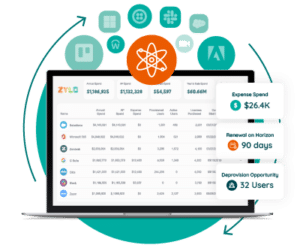 Visibility is foundational. Most organizations underestimate how many SaaS applications are in use, particularly when tools are purchased outside of IT. Zylo provides a complete view by identifying 100% of SaaS applications, regardless of how they enter the environment.
Visibility is foundational. Most organizations underestimate how many SaaS applications are in use, particularly when tools are purchased outside of IT. Zylo provides a complete view by identifying 100% of SaaS applications, regardless of how they enter the environment.
With full discovery, teams can:
- Eliminate shadow IT and unmanaged software
- Identify redundant or overlapping tools
- Establish a single, authoritative record of all SaaS activity
Without this insight, consolidation efforts remain incomplete—and new sprawl can go undetected.
Define Objectives and Priorities
Consolidation efforts require direction. SaaS Management platforms translate raw data into clear objectives that align with business goals.
This enables teams to:
- Prioritize categories with high redundancy or spend
- Set quantifiable targets (e.g., reduce training tools by 30%)
- Monitor progress and course-correct in real time
Defined goals help keep consolidation focused, measurable, and aligned across stakeholders.
Make Informed Tool Selections
Choosing what to keep isn’t always obvious. User feedback and vendor claims can conflict with actual adoption data. Zylo surfaces license utilization, engagement levels, and business impact to guide decisions based on facts.
This helps organizations:
- Avoid retaining low-use or niche platforms
- Identify tools with broad value that are worth deeper investment
- Prevent functionality gaps that hinder workflows
A data-driven selection process ensures decisions are objective and outcomes are sustainable.
Support Users Through Change
The tools may change, but success depends on how people adapt. Even well-vetted platforms can underperform without the right enablement. Zylo provides IT and enablement teams with real-time engagement insights to identify adoption issues early.
Why this matters:
- Smooth transitions increase productivity and reduce resistance
- Early support drives stronger engagement with retained tools
- Visibility into user behavior allows targeted enablement where needed
Monitoring adoption ensures consolidation doesn’t stop at implementation—it supports lasting change.
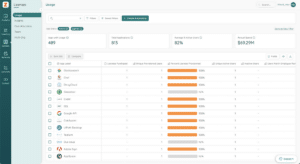
Plan Renewals with Precision
SaaS renewal dates can creep up fast, and without planning, organizations risk locking in spend before they’ve had time to evaluate. Zylo’s Automated Workflows and Renewal Calendar give teams the foresight they need to make informed decisions.
With early visibility, teams can:
- Avoid auto-renewing tools that no longer serve a need
- Evaluate alternatives with enough lead time to switch
- Align renewal decisions with roadmap milestones to increase leverage
Proactive planning ensures contract decisions support consolidation goals, not work against them.
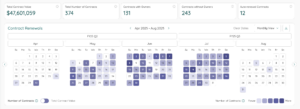
Automate License Optimization
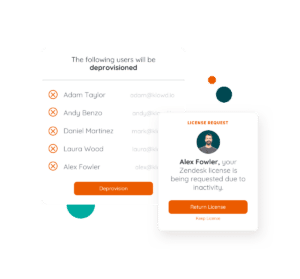 Manual license management is time-consuming and prone to error. Zylo automates key workflows like license reclamation, deprovisioning, and usage tracking—freeing up resources and reducing overspend.
Manual license management is time-consuming and prone to error. Zylo automates key workflows like license reclamation, deprovisioning, and usage tracking—freeing up resources and reducing overspend.
Automation creates impact by:
- Reclaiming unused licenses before they generate waste
- Ensuring new users get appropriate access from day one
- Enforcing efficiency without relying on ad hoc audits
With automated optimization, license hygiene becomes part of the daily process—not a quarterly scramble.
Build Long-Term Governance
Even the most successful consolidation effort can unravel without ongoing oversight. Zylo enables governance controls that scale with the business.
This helps organizations:
- Flag and review new purchases before they introduce redundancy
- Track growth by category to identify early signs of sprawl
- Embed approval workflows into procurement processes
Governance may get a bad rap for blocking new software purchases. However, it’s critical to ensure those purchases are intentional, value-driven, and aligned with enterprise goals from the start.
Common Mistakes When Buying New Software
Software purchasing is easy. Buying the right software is where most teams struggle. Without a structured, data-informed approach, new tools can introduce unnecessary complexity, duplicate functionality, and long-term cost. These common mistakes often undermine consolidation efforts. Here’s how to avoid them.
Buying Without Portfolio Context
New purchases are frequently made in isolation, without considering how they fit into the existing stack. Teams focus on immediate needs or feature sets, rather than overlap or strategic alignment.
Why it matters:
Unvetted purchases lead to redundancies, fragmented workflows, and lower tool adoption. They also limit consolidation opportunities later.
What to do instead:
- Evaluate existing tools in the same category
- Review utilization and engagement metrics
- Compare features and outcomes with similar platforms
- Assess how new tools align with long-term goals
Understanding what you already own is the first step to buying strategically.
Over-Relying on Department-Level Decisions
Fast departmental purchases may solve short-term needs—but they often create fragmentation and governance gaps across the organization.
Why it matters:
Uncoordinated buying results in shadow IT, inconsistent data, and added support overhead. It also makes consolidation more difficult down the line.
What to do instead:
- Establish intake and review processes for all software requests
- Include IT, procurement, and SAM in final approval
- Provide teams with flexibility while maintaining oversight
Cross-functional alignment supports agility without sacrificing governance.
Ignoring Renewal Impact
Teams often add new tools without checking existing contracts, resulting in redundant functionality and overlapping costs.
Why it matters:
Stacking new tools on top of existing ones leads to sunk cost and delays rationalization efforts.
What to do instead:
- Review current contract timelines before approving new software
- Time transitions to coincide with renewal cycles
- Negotiate flexible terms to phase out legacy tools
Purchasing in sync with renewals prevents avoidable spend and accelerates consolidation.
Skipping Stakeholder Involvement
When procurement or IT selects tools in isolation, adoption often suffers. Key users may resist the change—or abandon the tool entirely.
Why it matters:
Low engagement reduces value and increases the chance of duplicate tool adoption.
What to do instead:
- Involve power users and business owners in the evaluation process
- Validate use cases and workflows before selecting vendors
- Share outcomes and build consensus early
Adoption starts with buy-in. Collaborative selection drives stronger long-term use.
Prioritizing Features Over Business Needs
Teams may choose platforms based on the longest spec sheet, not what the business actually requires.
Why it matters:
Overbuilt tools drive up complexity and cost without improving outcomes.
What to do instead:
- Map product features to specific use cases
- Focus on solving core needs efficiently
- Avoid excess functionality that adds noise, not value
Feature-rich doesn’t always mean fit-for-purpose.
Misaligning with Strategic Objectives
A tool might support one team’s needs but work against broader enterprise goals—such as security, scalability, or standardization.
Why it matters:
Tools that conflict with enterprise strategy introduce risk, inefficiency, and governance headaches.
What to do instead:
- Use shared evaluation frameworks aligned to business priorities
- Vet tools for compatibility with security and compliance standards
- Choose platforms that support scale and long-term integration
Tool selection should reinforce—not undermine—enterprise direction.
Neglecting User Experience and Adoption Potential
Software that’s hard to learn or use will fail, regardless of how well it scores on paper.
Why it matters:
Poor UX results in low adoption, inconsistent usage, and wasted spend.
What to do instead:
- Evaluate usability during trials or demos
- Prioritize intuitive platforms that require minimal training
- Ensure onboarding support is in place before rollout
A great tool delivers value only when it’s actually used.
Failing to Plan for Long-Term Integration
New tools that don’t integrate well with existing systems create workflow silos and reporting blind spots.
Why it matters:
A lack of integration limits visibility, slows down collaboration, and adds manual work.
What to do instead:
- Assess compatibility with key systems (SSO, collaboration, analytics)
- Confirm availability of APIs, connectors, or native integrations
- Prioritize platforms that enhance—not isolate—your existing environment
Seamless integration protects data continuity and operational efficiency.</p>
Tech Stack Consolidation Is a Strategic Imperative
SaaS portfolios continue to grow. Without a long-term strategy, organizations face mounting waste, operational inefficiencies, and unmanaged risk.
Consolidation provides an opportunity to reset. It helps teams eliminate redundancy, reduce costs, strengthen security, and drive more value from their investments. But the impact extends beyond efficiency. With the right approach, consolidation becomes a foundation for scalable governance and smarter decision-making.
Organizations that embed consolidation into SaaS Management—supported by accurate data, automation, and cross-functional alignment—are better positioned to control costs, improve performance, and adapt to what’s next.
Ready to consolidate smarter? See how Zylo powers tech stack consolidation at scale by booking a demo. Or stay ahead of SaaS trends and best practices with insights delivered monthly—subscribe to our newsletter.


